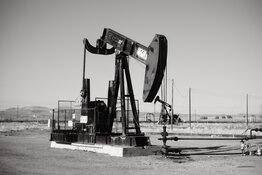Humans and bacteria share a surprising number of features, not least in what they consider good food. In general, the smaller and simpler the molecule, the easier it is to digest. So, about 50 million years ago, when and where bacteria had a chance to chow down on some of the rich hydrocarbons we call oil, one might expect them to start on the smaller, tidier mouthfuls, and indeed they did.
What's left today of these bacterial banquets are deposits of oil molecules so big and cumbersome that they flow like molasses in winter, if at all. At the extreme end is bitumen, which looks rather like sticky asphalt:

The oil sands that contain this heavy oil and bitumen have long posed an intriguing "what-if" for the industry. heir potential is staggering. One of the world's largest deposits, in the Canadian province of Alberta, spreads over the size of Wisconsin and may hold two trillion barrels of oil—eight times the reserves of Saudi Arabia.
For just about as long, however, oil sands have been minor players at best in the world's energy picture. The very qualities that native peoples have exploited to seal their boats make these heavy oils and bitumen tough to suck out of the ground and shove down a pipeline. And that's before they even get to a refinery.
Two developments in recent years have brought oil sands in from the cold: rising oil prices and new technology to pry bitumen out of deposits and make it run, not walk, to the nearest processing facility.
So let's take a look at how oil sands came about and what we can do with them.
The Tale of Two Oil Deposits
We're back to millions of years ago, this time to the hundreds of millions, when algae and the simple organisms that fed on them died, drifted down to the seafloor and were gradually buried under sediments and subsequent generations of ancient life.
As the ages passed, the pressure of layers above and heat from inside the earth broke down and reassembled these simple plants and animals into chains of carbon atoms bristling with hydrogen. Under pressure, these hydrocarbons squeezed through grainy, porous sedimentary rock until blocked by nonporous rock, known as capstone. There accumulated the first of our tale, a deposit of what we now call conventional oil.
The other deposit was in for a second ride. Geological forces lifted these oil-bearing rocks up toward the surface of the earth, within reach of water and bacteria. You know what happened next.
Because of this additional history, oil sands differ in structure as well as content from conventional oil deposits. The bitumen coats the grains of sand like a film and is in turn surrounded by water. Scraping the bitumen off the grains is the first step in extraction.
The uplifting also means that oil sands deposits are relatively shallow: some can even be surface-mined like coal.
This geological process happened in places like Venezuela and the United States, and particularly in Canada. In the province of Alberta are three major oil sands areas: the Athabasca (the largest), Peace River and Cold Lake. Current estimates put the combined bitumen in these deposits at 1.7 trillion barrels, and some geologists believe more field work will jack that number up a fair bit further.
The catch is that, at present, only 10% or 170 billion barrels of that bitumen is considered economically recoverable, that is, worth a producer's considerable effort to bring it to market. Even so, 170 billion barrels places Alberta second only to Saudi Arabia in terms of proven oil reserves, and ever-developing technology is likely to bring more in reach.
We're going to focus on Alberta because it's home to the largest and most developed oil sands deposits in the world.
To Market, to Market: Step 1
Surface-mining operations dig up and crush the oil-soaked rock, then mix it with water heated to 50-80°C. In such conditions, the bitumen floats off. All told, bitumen recovery from strip mines approaches 90%, and the mining and processing costs come in at about US$8.00 per barrel.
However, only about 20% of Alberta's bitumen is shallow enough for surface mining. The remaining 80% requires drilling and in-situ methods that extract the oil from the rocks in place. There are several methods to do this, and more in development. What they generally have in common is pumping down steam to heat the trapped oil, making it less viscous. Then a producer can actually pump the bitumen to the surface.

Many oil sands companies use this in-situ method, called steam-assisted gravity drainage (SAGD).
Another factor in-situ methods have in common is the large amounts of energy required to generate the steam. At present that energy usually comes from natural gas, which comprises 65-80% of total operating costs.
According to government statistics, Alberta is host to 91 producing oil sands projects as of 2009. Of these, only four are mining projects, while the remaining 87 use various in-situ recovery methods. In 2009 those projects produced an average of 1.49 million barrels of bitumen per day (bbpd), which represents more than 40% of Canada's total oil production. That 1.49-million figure is projected to reach 3 million bbpd by 2018.
To Market, to Market: Step 2
However it's recovered, this stiff black glop needs further work in order to sell it. An oil sands producer has two choices: to upgrade it and make synthetic oil, or to dilute it with lighter hydrocarbons so it can run down a pipeline to a refinery.
Upgrading usually requires two steps. First the bulky hydrocarbon chains are broken into smaller ones in a process called hydrocracking; upgraders may also remove carbon to produce the smaller chains along with coke. The second step adds hydrogen to "fill out" the new carbon chains and to remove impurities like sulfur. Currently five upgraders in Alberta churn out a bit over 1 million barrels of synthetic crude oil each day, and there are plans for more.
Bitumen that's not upgraded is blended with diluents that make it runny enough to pipe to refineries throughout North America. The diluents are usually a mixture of light hydrocarbons, such as light crude oil and naphtha. Companies can recycle diluents that stay within Alberta, a significant consideration in project planning.
The investment to get the industry to this stage has been massive. Between 1999 and 2009, an estimated $91 billion was pumped into developing Alberta's oil sands. In 2009 industry invested another $10 billion, and almost $170 billion worth of oil sands projects are currently underway or proposed in the province.
Environmental Issues
Environmental groups have labeled bitumen "dirty oil" and are calling for an end to oil sands operations. They have three main complaints: that ugly mines and tailings ponds destroy habitat, that projects gulp energy and emit significant emissions for every barrel of oil, and that the whole process uses a significant amount of water.
The groups are certainly right on some fronts. In-situ operations cause minimal disturbance, but surface mining—even though it represents only 20% of oil sands operations—does make an unsightly mess of boreal forests and marshlands. And in-situ projects have their own issues. The roughly 30 cubic meters of natural gas and three barrels of water consumed to produce one barrel of bitumen are indeed high.
Well, oil sands aren't going away. Their potential is too vast, global demands for energy too high, and for governments like Alberta, they contribute too much to the coffers.
But more encouraging yet, industry is developing less-intensive techniques. Quick-drying tailings ponds can be returned to nature faster, for example. And companies have a double incentive to develop in-situ methods that require less energy and water: they would lower operating costs as well as mitigate complaints.
One of the current picks of the Casey Energy team is a company that's proving up an extraction method that's both more efficient and easier on the environment. . .a future winner if we've ever seen one. Sign up now to receive Casey's Energy Opportunities for only $39 per year—and find out all about this low-risk value play in oil sands.








































